Presentation Examples: Inspiring Ideas for Different Types of Presentations

When preparing for a presentation, it can be immensely helpful to look at examples for inspiration. Different situations require different approaches—whether you’re pitching a new idea to investors, presenting a strategy to your team, or educating an audience at a conference. In this blog post, we’ll explore presentation examples across various categories, breaking down how each can be structured for maximum impact.
By examining these examples, you’ll gain insights on how to tailor your own presentation based on your objectives and audience.

1. Business Pitch Presentation Example: The Investor Pitch
An investor pitch aims to secure funding by convincing potential investors that your business is a solid opportunity. It needs to be concise, compelling, and data-driven.
Key Components:
- Problem Statement: Start by highlighting a clear problem in the market that your product or service solves.
- Solution and Value Proposition: Clearly explain how your offering addresses the problem and what sets it apart from competitors.
- Market Opportunity: Provide data on the market size, growth potential, and target audience.
- Business Model: Outline how your business makes money and its scalability.
- Traction and Milestones: Showcase your progress so far, such as revenue growth, customer acquisition, or partnerships.
- Funding Ask and Use of Proceeds: Specify how much funding you’re seeking and how you plan to use it.
Example Structure:
- Slide 1: Introduction with a compelling statistic or quote about the industry.
- Slide 2: Problem statement illustrated by customer pain points.
- Slide 3: Solution overview with visuals of your product or service.
- Slide 4: Market opportunity with key figures and growth trends.
- Slide 5: Business model explanation with revenue streams and pricing strategy.
- Slide 6: Traction, including growth charts, testimonials, or case studies.
- Slide 7: Funding request and breakdown of how funds will be allocated.
2. Sales Presentation Example: Closing a Deal with a Client
A sales presentation should focus on understanding your client’s needs and presenting your product or service as the ideal solution. It needs to be persuasive, highlighting the benefits and outcomes your offering provides.
- Understanding the Client’s Pain Points: Begin by discussing the challenges your client faces and what they’re hoping to achieve.
- Tailored Solution: Customize your pitch to show how your offering directly solves their specific problems.
- Benefits and ROI: Highlight the key benefits and the return on investment your client can expect.
- Case Studies and Testimonials: Provide examples of similar clients who’ve seen success with your solution.
- Next Steps and Call to Action: Clearly outline the next steps, whether it’s scheduling a demo, signing a contract, or a follow-up meeting.
- Slide 1: Client-specific introduction with their pain points and goals.
- Slide 2: Overview of your product or service, focusing on features that matter most to the client.
- Slide 3: Detailed benefit breakdown with visuals showing outcomes and results.
- Slide 4: Case study of a similar client, highlighting the problem, solution, and positive results.
- Slide 5: ROI analysis with projections tailored to the client’s business.
- Slide 6: Call to action, clearly stating the next steps or decision points.
3. Strategy Presentation Example: Presenting a New Business Strategy to Executives
A strategy presentation is about communicating a clear vision and plan for achieving specific goals. When presenting to executives, it’s crucial to be concise, data-driven, and aligned with business objectives.
- Executive Summary: Begin with a high-level overview of the strategy and its importance.
- Current Situation Analysis: Analyze the current landscape, including strengths, weaknesses, opportunities, and threats (SWOT).
- Strategic Objectives: Clearly define the goals and objectives of the strategy.
- Action Plan: Break down the steps, initiatives, and timelines needed to achieve the objectives.
- Resource Allocation: Highlight the resources (people, budget, technology) required for implementation.
- Risk and Mitigation: Address potential risks and how they’ll be managed.
- KPIs and Metrics: Define how success will be measured and monitored.
- Slide 1: Executive summary with a bold statement about the strategy’s potential impact.
- Slide 2: SWOT analysis or current situation overview.
- Slide 3: Strategic objectives, laid out as clear, measurable goals.
- Slide 4: Action plan timeline, including major milestones and deliverables.
- Slide 5: Resource allocation, specifying budget and team responsibilities.
- Slide 6: Risk assessment and contingency plans.
- Slide 7: Key performance indicators and how progress will be tracked.
4. Educational Presentation Example: Teaching a Concept to Students
An educational presentation is about breaking down complex information into digestible parts. The goal is to inform and engage, making sure your audience walks away with a solid understanding of the subject.
- Introduction to the Topic: Provide a clear overview of what the audience will learn and why it’s important.
- Key Concepts Explained: Break the content into bite-sized sections, with each section covering a key concept.
- Visual Aids and Examples: Use diagrams, charts, and examples to clarify and reinforce key points.
- Interactive Elements: Incorporate quizzes, polls, or discussions to check for understanding and maintain engagement.
- Summary and Review: Recap the key concepts and answer any questions the audience might have.
- Slide 1: Topic introduction with a statement of objectives (e.g., “Today, we’ll explore the fundamentals of digital marketing”).
- Slide 2: Breakdown of the first key concept with visuals and a real-world example.
- Slide 3: Explanation of the second concept, including a brief interactive activity (e.g., a poll or quiz).
- Slide 4: Visual demonstration or case study related to the topic.
- Slide 5: Summary slide recapping the main points and next steps for further learning.
- Slide 6: Open the floor for questions and discussion.
5. Motivational Presentation Example: Inspiring an Audience to Take Action
A motivational presentation aims to inspire and energize the audience. Whether you’re speaking at a conference or leading a team meeting, the goal is to evoke emotion and drive people to take action.
- Personal Story or Anecdote: Start with a relatable story that sets the tone and connects with the audience.
- Core Message or Theme: Define the central message that you want the audience to take away.
- Powerful Examples or Quotes: Use impactful quotes or stories to reinforce your message and add emotional weight.
- Call to Action: Clearly communicate what you want the audience to do next, and why it matters.
- Closing with a Memorable Statement: End with a statement that lingers in the minds of your audience.
- Slide 1: Opening with a powerful quote or a story that resonates with the audience.
- Slide 2: Introduce the core message or theme (e.g., “The Power of Resilience in Overcoming Adversity”).
- Slide 3: Share a personal experience or example that illustrates your message.
- Slide 4: Reinforce the theme with a memorable quote or an inspiring example from history.
- Slide 5: Call to action, urging the audience to apply what they’ve learned or commit to change.
- Slide 6: Closing with a motivational statement or vision for the future.
Great presentations are built on a foundation of clear structure, relevant content, and a deep understanding of your audience’s needs. By examining these examples and tailoring your approach to fit your specific context, you can create presentations that are impactful, persuasive, and memorable. Whether you’re pitching, educating, or inspiring, having a well-organized presentation outline will give you the confidence and clarity needed to deliver your message effectively.
Table of contents
20 Great Examples of PowerPoint Presentation Design [+ Templates]
Updated: August 06, 2024
Published: May 24, 2010
When it comes to PowerPoint presentation design, there's no shortage of avenues you can take.

While all that choice — colors, formats, visuals, fonts — can feel liberating, it‘s important that you’re careful in your selection as not all design combinations add up to success.
In this blog post, I’m sharing some of my favorite PowerPoint tips and templates to help you nail your next presentation.
Table of Contents
What makes a good PowerPoint presentation?
Powerpoint design ideas, best powerpoint presentation slides, good examples of powerpoint presentation design.
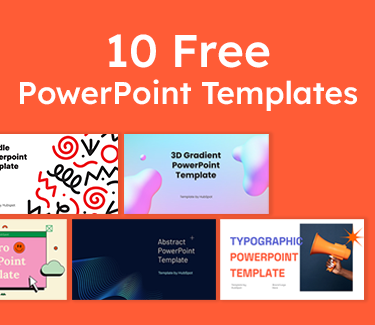
10 Free PowerPoint Templates
Download ten free PowerPoint templates for a better presentation.
- Creative templates.
- Data-driven templates.
- Professional templates.
Download Free
All fields are required.
You're all set!
Click this link to access this resource at any time.
In my opinion, a great PowerPoint presentation gets the point across succinctly while using a design that doesn't detract from it.
Here are some of the elements I like to keep in mind when I’m building my own.
1. Minimal Animations and Transitions
Believe it or not, animations and transitions can take away from your PowerPoint presentation. Why? Well, they distract from the content you worked so hard on.
A good PowerPoint presentation keeps the focus on your argument by keeping animations and transitions to a minimum. I suggest using them tastefully and sparingly to emphasize a point or bring attention to a certain part of an image.
2. Cohesive Color Palette
I like to refresh my memory on color theory when creating a new PowerPoint presentation.
A cohesive color palette uses complementary and analogous colors to draw the audience’s attention and help emphasize certain aspects at the right time.
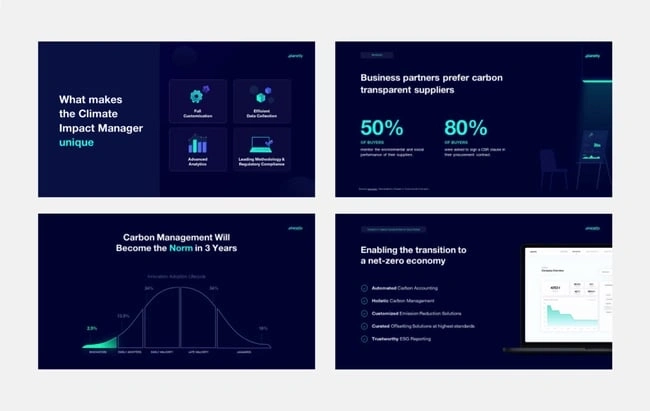
Image source
Mesmerize your audience by adding some neon colors and effects to your PowerPoint slides. Adding pops of color to your presentation will create visual interest and keep your audience engaged.
What I like: Neon will add personality and depth to your presentation and will help the information you're providing stand out and be more memorable.
2. Use an interesting background image.
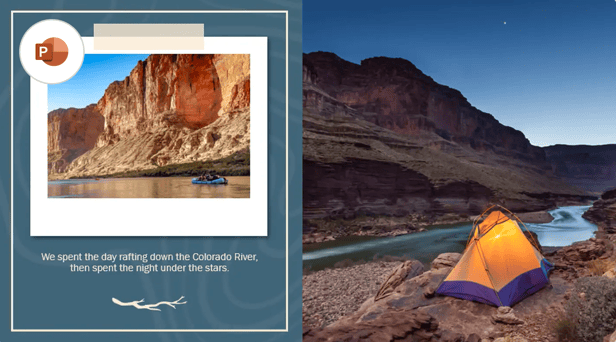
Do you have some interesting nature photos from a recent road trip? Or maybe a holiday passed, and you have gorgeous photos to share? If so, consider incorporating them into your PowerPoint.
What I like: PowerPoints don't have to be stuffy and boring. They can be fun and a unique or interesting background will enhance the experience of your presentation.
3. Or be minimal.
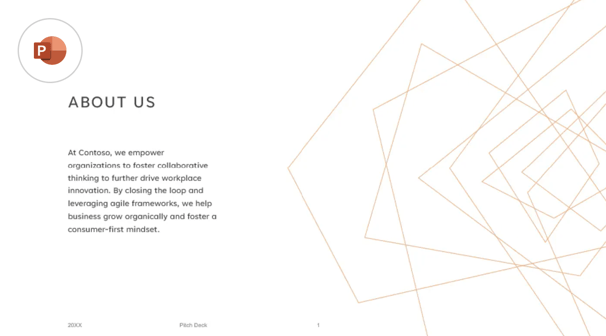
Have you ever heard of K.I.S.S.? Not the band! I mean, Keep It Simple, Sweetheart. If you're worried too many colors or visuals could take attention away from the message of your presentation, consider going minimal.
Pro tip: Stick to no more than three colors if you're going for a minimalist design in your slides.
4. Incorporate illustrations.
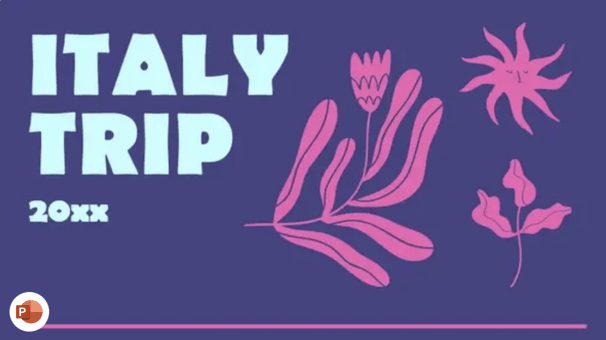
Illustrations are a great way to highlight or break down a point in your presentation. They can also add a bit of whimsy and fun to keep viewers engaged.
5. Use all caps.
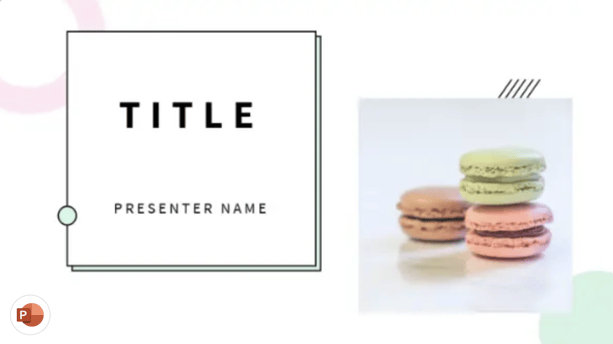
Using all capital letters can draw your audience's eyes to where you need them, helping cement your message in their minds. It can also just be aesthetically pleasing.
Pro tip: If you choose to use all capital letters, use varying fonts so readers can tell which information is important and which are supporting details.
6. Alternate slide layouts
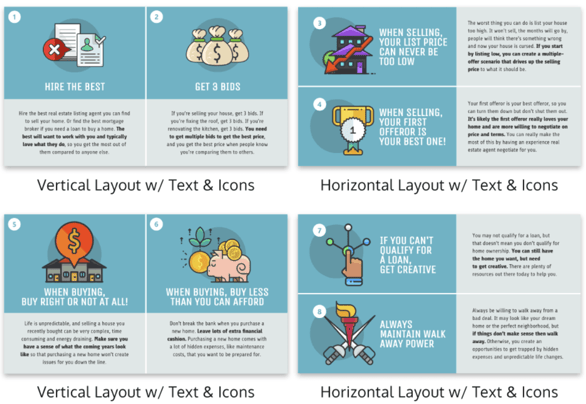
You don't want readers to grow bored with your presentation. So, to retain visual interest, use alternating slide layouts. The example above shows PowerPoint slides alternating between vertical and horizontal layouts.
This keeps things interesting and ensures your presentation isn't monotonous.
7. Inject a little humor.
Humor is a great way to drive a point home and help people remember the information you're presenting. People remember a good joke, so if you have a funny pun to connect to a concept in a presentation, why not use it in a slide?
Pro tip: Remember you're in a professional setting, so keep your jokes appropriate. If you're worried a joke can get you a meeting with HR, then keep it to yourself.
8. Use duotones.

Duotones (or gradience) can take the aesthetic of your PowerPoint to new levels. They can provide a calming energy to your presentation and make viewers feel relaxed and eager to stay focused.
9. Include printed materials.
Let's say you have a PowerPoint you're proud of, but you want to go that extra mile to ensure your audience understands the material. A great way to do this would be to supplement your presentation with printed materials, as such as:
- Pamphlets
- Printed slides
- Short quizzes on the material
10. Keep it to one chart or graph per slide.
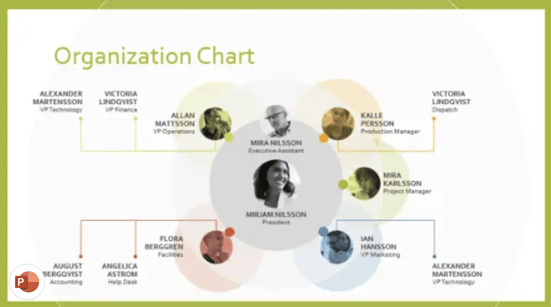
This is both a design example and a warning. Graphs and charts are an excellent way of displaying quantitative data in a digestible format.
However, you should have no more than one graph or chart per slide so your presentation doesn't get too confusing or muddled.
11. Use a large font.
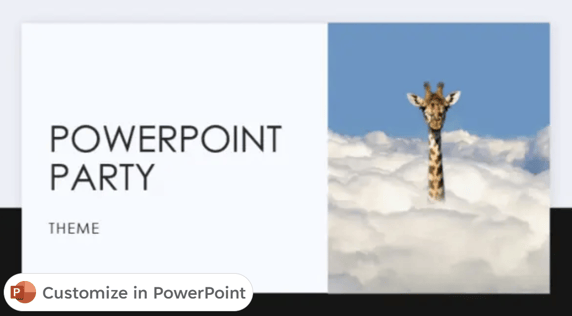
Just like capital letters, a large font will help your shift your audience's focus to key points in your presentation.
Pro tip: You can combine large fonts and capital letters to boost its effectiveness.
12. Include videos.
Embedding a video into your PowerPoint can help you expand on a point or effectively break down a complex topic. You can either embed a video from a platform like YouTube or TikTok or use HubSpot's Clip Creator to make your own.
Pro tip: Try to keep videos short, like, under a minute, and don't use more than one or two.
13. Use GIFs.
GIFs add more visual interest, and they can be a great way to add humor or personal touch to your PowerPoint presentation.
14. Use contrasting colors when comparing two ideas or arguments.
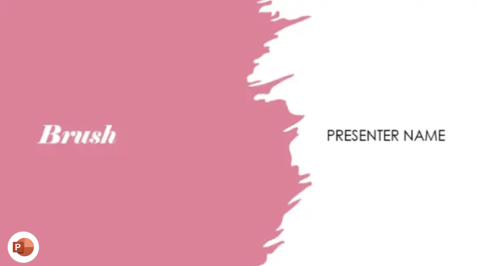
Contrasting colors can convey the difference between two opposing thoughts or arguments in a way that is visually appealing.
15. Add a touch of nature.

If you want your presentation to exude a calming energy to your audience, including images of trees, flowers, and natural landscapes can do the trick.
PowerPoint Theme Ideas
Atlas (theme).
Covering a more creative subject for a younger or more energetic audience? I’d recommend using the cover slide design below. Its vibrant red color blocks and fun lines will appeal to your audience.
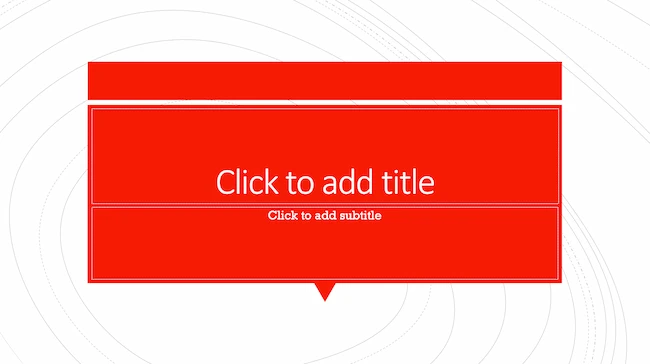

Creative PowerPoint (Template)
I like how this presentation template uses bright colors and plenty of white space to convey a modern but fun design. Organic shapes and geometric lines and patterns add an extra visual element (and personality) to the slides. Get it here .

This simplistic presentation example employs several different colors and font weights, but instead of coming off as disconnected, the varied colors work with one another to create contrast and call out specific concepts.
What I like: The big, bold numbers help set the reader's expectations, as they clearly signify how far along the viewer is in the list of tips.
10. “Pixar's 22 Rules to Phenomenal Storytelling,” Gavin McMahon
This presentation by Gavin McMahon features color in all the right places. While each of the background images boasts a bright, spotlight-like design, all the characters are intentionally blacked out.
What I like: This helps keep the focus on the tips, while still incorporating visuals. Not to mention, it's still easy for me to identify each character without the details. (I found you on slide eight, Nemo.)
11. “Facebook Engagement and Activity Report,” We Are Social
Here's another great example of data visualization in the wild.
What I like: Rather than displaying numbers and statistics straight up, this presentation calls upon interesting, colorful graphs, and charts to present the information in a way that just makes sense.
12. “The GaryVee Content Model,” Gary Vaynerchuk
This wouldn‘t be a true Gary Vaynerchuk presentation if it wasn’t a little loud, am I right?
What I like: Aside from the fact that I love the eye-catching, bright yellow background, Vaynerchuk does a great job of incorporating screenshots on each slide to create a visual tutorial that coincides with the tips. He also does a great job including a visual table of contents that shows your progress as you go .
13. “20 Tweetable Quotes to Inspire Marketing & Design Creative Genius,” IMPACT Branding & Design
We‘ve all seen our fair share of quote-chronicling presentations but that isn’t to say they were all done well. Often the background images are poor quality, the text is too small, or there isn't enough contrast.
Well, this professional presentation from IMPACT Branding & Design suffers from none of said challenges.
What I like: The colorful filters over each background image create just enough contrast for the quotes to stand out.
14. “The Great State of Design,” Stacy Kvernmo
This presentation offers up a lot of information in a way that doesn't feel overwhelming.
What I like: The contrasting colors create visual interest and “pop,” and the comic images (slides 6 through 12) are used to make the information seem less buttoned-up and overwhelming.
15. “Clickbait: A Guide To Writing Un-Ignorable Headlines,” Ethos3
Not going to lie, it was the title that convinced me to click through to this presentation but the awesome design kept me there once I arrived.
What I like: This simple design adheres to a consistent color pattern and leverages bullet points and varied fonts to break up the text nicely.
16. “Digital Transformation in 50 Soundbites,” Julie Dodd
This design highlights a great alternative to the “text-over-image” display we've grown used to seeing.
What I like: By leveraging a split-screen approach to each presentation slide, Julie Dodd was able to serve up a clean, legible quote without sacrificing the power of a strong visual.
17. “Fix Your Really Bad PowerPoint,” Slide Comet
When you‘re creating a PowerPoint about how everyone’s PowerPoints stink, yours had better be terrific. The one above, based on the ebook by Seth Godin, keeps it simple without boring its audience.
What I like: Its clever combinations of fonts, together with consistent color across each slide, ensure you're neither overwhelmed nor unengaged.
18. “How Google Works,” Eric Schmidt
Simple, clever doodles tell the story of Google in a fun and creative way. This presentation reads almost like a storybook, making it easy to move from one slide to the next.
What I like: This uncluttered approach provides viewers with an easy-to-understand explanation of a complicated topic.
19. “What Really Differentiates the Best Content Marketers From The Rest,” Ross Simmonds
Let‘s be honest: These graphics are hard not to love. I especially appreciate the author’s cartoonified self-portrait that closes out the presentation. Well played, Ross Simmonds.
What I like: Rather than employing the same old stock photos, this unique design serves as a refreshing way to present information that's both valuable and fun.
20. “Be A Great Product Leader,” Adam Nash
This presentation by Adam Nash immediately draws attention by putting the company's logo first — a great move if your company is well known.
What I like: He uses popular images, such as ones of Megatron and Pinocchio, to drive his points home. In the same way, you can take advantage of popular images and media to keep your audience engaged.
And if you want more templates and examples, you can download them here .
PowerPoint Presentation Examples for the Best Slide Presentation
Mastering a PowerPoint presentation begins with the design itself.
Get inspired by my ideas above to create a presentation that engages your audience, builds upon your point, and helps you generate leads for your brand.
Editor's note: This post was originally published in March 2013 and has been updated for comprehensiveness. This article was written by a human, but our team uses AI in our editorial process. Check out our full disclosure to learn more about how we use AI.
Don't forget to share this post!
Related articles.
![a presentation example How to Create an Infographic in Under an Hour — the 2024 Guide [+ Free Templates]](https://www.hubspot.com/hubfs/Make-infographic-hero%20%28598%20%C3%97%20398%20px%29.jpg)
How to Create an Infographic in Under an Hour — the 2024 Guide [+ Free Templates]
![a presentation example How to Create the Best PowerPoint Presentations [Examples & Templates]](https://knowledge.hubspot.com/hubfs/powerpoint.webp)
How to Create the Best PowerPoint Presentations [Examples & Templates]
![a presentation example 17 PowerPoint Presentation Tips From Pro Presenters [+ Templates]](https://www.hubspot.com/hubfs/powerpoint-design-tricks_7.webp)
17 PowerPoint Presentation Tips From Pro Presenters [+ Templates]
![a presentation example How to Write an Ecommerce Business Plan [Examples & Template]](https://www.hubspot.com/hubfs/ecommerce%20business%20plan.png)
How to Write an Ecommerce Business Plan [Examples & Template]

Get Buyers to Do What You Want: The Power of Temptation Bundling in Sales

How to Create an Engaging 5-Minute Presentation
![a presentation example How to Start a Presentation [+ Examples]](https://www.hubspot.com/hubfs/how-to-start-presenting.webp)
How to Start a Presentation [+ Examples]

120 Presentation Topic Ideas Help You Hook Your Audience

The Presenter's Guide to Nailing Your Next PowerPoint
![a presentation example How to Create a Stunning Presentation Cover Page [+ Examples]](https://www.hubspot.com/hubfs/presentation-cover-page_3.webp)
How to Create a Stunning Presentation Cover Page [+ Examples]
The weekly email to help take your career to the next level. No fluff, only first-hand expert advice & useful marketing trends.
Must enter a valid email
We're committed to your privacy. HubSpot uses the information you provide to us to contact you about our relevant content, products, and services. You may unsubscribe from these communications at any time. For more information, check out our privacy policy .
This form is protected by reCAPTCHA and the Google Privacy Policy and Terms of Service apply.
You've been subscribed

IMAGES
VIDEO